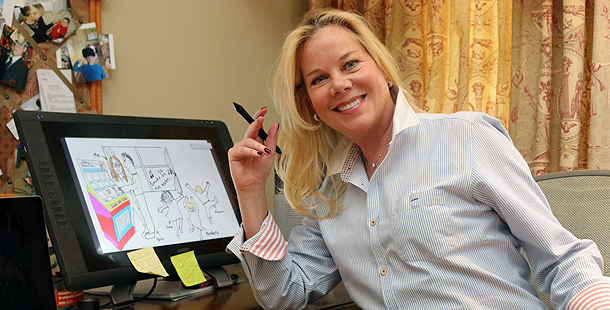
Former model recounts her mother’s life in graphic novel
Former model recounts her mother’s life in graphic novel
Velvet Haney is standing in the living room of her Forest Hill home, re-enacting a scene from her teen years where her father embarrassed her outside of a Toronto movie theatre.
It’s February, 1972, and Billy Richardson has had one too many gin martinis. There’s a lineup of people waiting to get into the showing of A Clockwork Orange, and since he knows the manager of the theatre he’s going to try to bypass the queue.
“[The manager’s] telling my father, no, no,” Haney says, hands motioning a one-fingered negative. “What my father says is, ‘You bitch’, and he kicks her and all the flowers that she was holding fall down.”
Miming the punches thrown, she relates the scene of the ensuing encounter with the ushers: “He lifts the one up, and smashes the other one. He said to me, ‘Come over here. Just get a cab. I have a gun in my pocket’.”
It wasn’t the first of her father’s hijinks to land him in a lot of trouble. One standout episode Haney candidly shares with the Town Crier, where he drowned cows in Tennessee and fled to Canada after a shootout with local farmers, is not mentioned in her graphic novel, The Mousehouse Years: A Memoir, but plenty more are.
The 60-year-old former model started writing the novel out in 2006, but switched it after reading the first chapter and setting it aside. It shares, in great detail, her parents’ lives, in particular the years spent in a poor part of town: Alexandra Park.
“I had actually written pages in prose, and I re-read it,” she recalls. “I put it away for three months, which is what Stephen King recommended in that book On Writing. “I read it and thought, ‘Oh God…”
It wasn’t until after she read Alison Bechdel’s Fun Home that she decide to switch the medium.
“I kind of thought, ‘What’s this?’ I read [Fun Home], and remember being so impressed with it. I remember driving in the car with my kids, and stopping at a light, thinking, ‘If I could only draw, that’s the way I would tell my story’.
“It was a total epiphany moment — with the light bulb over the head — and I came home, and I thought, let me take the beginning of the book, the prologue, and if I can draw it in little boxes, I can tell the story like that. I did it, and I thought, ‘That’s not so bad’.”
She had some help, though. She hired a computer program and purchased a new computer, replete with Photo Elements, the software she used to draw the childlike images.
Haney’s coy when she talks about the “stick figures” in Mousehouse, the home where she lived with her five siblings and mom Meg Richardson, who is the focus of most of the book.
“All the way along, people would say I couldn’t do this, you’ll get rejected,” she said. “As I was drawing, I would send it out.
“People would say, ‘You have to hire an illustrator, you don’t have the background, blah blah, blah’. But the images told the story I wanted to tell. I became very fond of them.”
Coming back to her ironic anecdote about violence in the queue for A Clockwork Orange, Haney admits she’s drawing up another memoir, this time vignettes from her modelling career during the late 1970s and early ’80s.
As for the response Haney hopes to get from readers of The Mousehouse Years, it’s mostly positive.
“For me, I get a real kick out of the fact people say they couldn’t put it down,” she shares. “It’s the old Toronto or the kids’ escapades or the bigger-than-life romance, or the cathartic effect of someone who has had sexual abuse in their life.”

